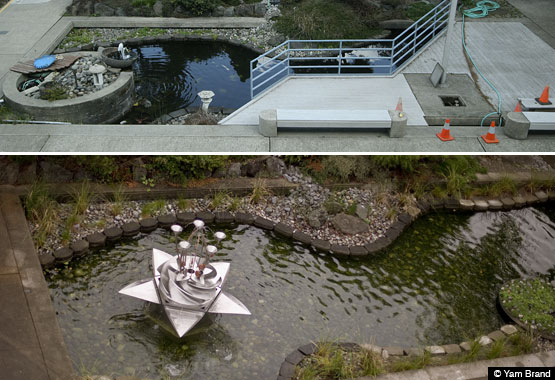
Wastewater Treatment Plant
Seattle
“Of recent years great strides have been made in the culture of new varieties of water-lilies in the open air.”
– Encyclopedia Britannica, 11th edition, 1911.
The kinetic sculpture, Water Plant is the outcome of an active two-year collaboration between Fels, the staff of Seattle’s South Treatment Plant, the commissioning agency 4Culture, and metal fabricator Benson Vess, with whom Fels has often worked in the past. Fels was interested in the project because it promised to be collaborative, and because it dealt with industrial treatment of one of our most basic natural resources.
Water, balance and gravity animate the sculpture. As such, Water Plant comments on the work being done at the facility where the flow of water is gravity-fed and steady movement is used to clean it. The levered motion of the sculpture is simple, visible and transparent. Its function, which they will know from teeter-totters, will be recognizable even to kids.
The sculpture was designed to be elegantly whimsical, a ‘natural machine’ that brings playful attention to the way water works. Like the treatment plant, the sculpture uses straight-forward universal mechanics. The stainless steel sculpture incorporates and is built around a surplus impeller from the facility. The 2400 lb stainless steel impeller itself is built around a spiral, a form found throughout nature. The sculpture’s scale is largely determined by the form and mass of the impeller. To accentuate the sense of a manufactured ‘plant’ the petals were carefully machined, and secured with rivets and other visible fasteners.
The sculpture’s base (the plant’s sepal) is made up of a connected series of ten equilateral triangles, which together create a truncated icosahedron, Plato’s solid for water. The same triangular form is also seen in the molecular structure of H2O, in the Hindu symbol for water and the alchemical sign for water. The impeller spiral has five blades. The sculpture features a pentagram as the base plate supporting the impeller, and has five upper funnels standing in for ‘stamens’ (the funnels suggest the laboratory/testing functions at the facility), and five lower triangular shaped petals, another set of catchment devices. The geometrical mandala-like flower shape (especially visible when looking down from the conference rooms in the adjacent administration building) and the motion of the water being dumped into the pond are soothing and meditative. The funnels and petals fill with and release water in a random manner, suggesting a natural phenomenon.
The pond where the sculpture is at work was created a half century ago, and over time had acquired a couple small fountains, a flag-pole and a deck. Fels had the additions removed. Using materials sourced around the treatment facility and from a native plant nursery nearby, he re-landscaped the pond. Working away in the newly configured pond, Water Plant invariably puts smiles on the faces of visitors to the treatment facility.


